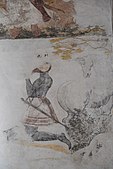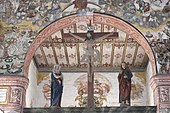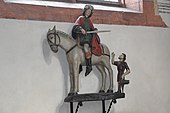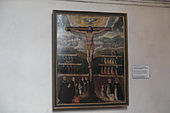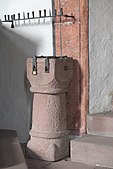Martinskapelle (Burgstadt)
The Martinskapelle in Bürgstadt , a market in the Lower Franconian district of Miltenberg ( Bavaria ), was probably built in the first half of the 10th century. It is considered one of the oldest churches in Franconia . Until the construction of the church of St. Margareta, first mentioned in 1247, it served as a Catholic parish church . The wall and ceiling paintings from the 16th century have been preserved in the Martin's Chapel. The chapel is one of the protected architectural monuments in Bavaria.
history
Since Bürgstadt was the original parish of the southwestern Mainviereck, it is assumed that there was a much older predecessor building before today's St. Martin's Chapel was built. The patronage of St. Martin also points to a church building that dates back to Franconian times. In the first half of the 13th century, a new church was built barely 100 meters from St. Martin's Chapel and dedicated to St. Margaret . It replaced the Martinskapelle in its function as a parish church. The Martin's Chapel, which was badly damaged by fire at the end of the 13th century, fell into disrepair. It was not until the end of the 14th century that restoration began, presumably in connection with the establishment of an early measurement foundation .
Only a few remains of the wall paintings that were carried out during this time have survived on the pillars of the triumphal arch , as they - like the paintings from around 1490 - were largely repainted at a later date.
At the end of the 15th century, today's west facade was designed with the main portal. In 1589 the roof turret was placed over the west gable . He still owns a bell from the 14th century on which the names of the four evangelists are engraved.
In the same year, Andreas Herneisen started painting the choir , the ceilings and the gallery . From 1590 a painter, who was also entrusted with the painting of the town hall and the production of the coats of arms of the meeting room, continued the work. This glass and flat painter, who is referred to by his signature with the initials IBM (IBMichel?), Also created the cycle of medallions in the nave of the Martin's Chapel in 1593 .
architecture
The Martinskapelle is a hall building with an almost square choir . The main Gothic portal on the west facade is dated around 1490. The south portal, which is also pointed arch, was installed in 1590 in place of an older, Gothic portal.
West portal
The west portal is profiled with bars and grooves. In the tympanum , a relief depicts the patron saint of the church, St. Martin, who sits on his horse and shares his cloak with a beggar kneeling on two boards. In the apex of the pointed arch, Christ, whose head is surrounded by the nimbus , hovers with the divided half of the cloak in his hand. The lintel is supported by consoles carved with angels playing music. In the middle of the lintel, a small sign with a stonemason's mark indicates the creator of the portal. The coat of arms on the side of the portal is attributed to Walther Krag from Koblenz, who is mentioned in 1483 as a pastor of Bürgstadt and Miltenberg .
Gallery pictures
The pictures on the gallery balustrade depict Christ and the twelve apostles . They were created in the course of the renovation of the gallery in the years 1729 to 1733.
Wall and ceiling paintings by Andreas Herneisen
When designing the ceiling, the ornamental representations were painted directly on the wood, while the figurative representations were applied to paper and glued to the wooden boards. In addition to the sun, moon and stars, angels, the evangelist symbols , two blessing saints, the dove of the Holy Spirit, God the Father and Christ can be recognized. In their entirety, they are supposed to represent heaven.
On the east wall of the choir, Andreas Herneisen left his signature AH with the year 1589. The paintings were made using the Secco technique and were whitewashed until 1907. They are in a poor state of preservation because of the moisture in the walls. Three subject areas can be distinguished: coats of arms, evangelists and church fathers in an almost life-size representation as well as scenes from the life of St. Martin.
The three arms is the emblem of the Mainz Cathedral Chapter, the coat of arms of the archbishop and elector of Mainz, Wolfgang von Dalberg , and the crest of Wolff Eberhard von Ehrenberg , the kurmainzischen top civil servant in Miltenberg .
The four evangelists, Matthew, Mark, Luke and John, are shown with their attributes , like the four church fathers, Ambrosius, Augustine, Hieronymus and Gregory, and some of their names are still recognizable.
The scenes of the legend of Martin show how Saint Martin shares his cloak with a beggar, how he takes off his armor in a dream vision and receives the episcopal ordination. Further scenes show Martin healing a man possessed, visiting a sick man and finally his death.
Medallion cycle of the IBM
The painter, who left his initials, his coat of arms and the year 1593 on the north wall of the nave, used wood and copper engravings by German and Dutch masters as templates for the cycle of medallions in the Martin's Chapel . Scenes from the Old and New Testament are shown on a total of 40 medallions.
The top row consists of 14 medallions. It begins in the southern nave with the creation of the world and ends in the northern nave with the erection of the brazen serpent .
The middle row is dedicated to the childhood and ministry of Jesus. The following are depicted on twelve medallions: Annunciation , Visitation , Adoration of the Shepherds, Circumcision of Jesus, Adoration of the Magi , Simeon's hymn of praise , killing of the innocent children , the twelve-year-old Jesus in the temple, baptism of Jesus in the Jordan, wedding in Cana , raising of Lazarus and the attempted stoning of Jesus.
The bottom row consists of 15 medallions with scenes of the Passion , the Resurrection and Ascension of Christ and the Miracle of Pentecost . The entry into Jerusalem, the Last Supper , the washing of the feet, Jesus on the Mount of Olives, the betrayal of Judas, Peter denies Jesus, Jesus before Caiaphas, Jesus before Pilate, the scourging of Jesus, the crowning of thorns and mockery, Ecce homo , the stations of the cross and the finding of the Cross by Saint Helena .
On the west side of the choir arch is the depiction of the Last Judgment .
Furnishing
- The high altar dates from around 1620. St. Leonhard is on the left, St. Birgitta of Sweden on the right . In the upper niche, the Archangel Michael is depicted, who weighs souls. The altarpiece with the scene of the division of the mantle of St. Martin was created in 1746 by the painter and sculptor Nikolaus Hooff . The antependium , on which the church patron is also depicted, presumably comes from Nikolaus Hooff .
- The Wendelin altar with the sculptures of the patron saint, St. Joseph with the baby Jesus and St. Antonius of Padua bears the signature of Nikolaus Hooff from Mudau and his coat of arms with a jumping unicorn. It was commissioned in 1741 and completed in 1748.
- A late Gothic crucifixion group dated around 1500 hangs under the triumphal arch .
- The carved figure of St. Martin on the north wall of the choir also dates from around 1500. St. Martin sits on his horse and shares his cloak with a sword, next to the horse stands the beggar who leans on a crutch.
- On the wall above the pulpit there is a figure of St. Wendelin , who was the destination of a pilgrimage around 1730.
- On the south wall of the choir hangs an oil painting on wood, the picture of the donor for the mayor Peter Schneider from Burgstadt. It bears the signature of Andreas Herneisen and is labeled 1589. In the center of the painting the crucified one is depicted, who is not dead, but instead directs his gaze to heaven and over whose head the dove of the Holy Spirit hovers. The cross grows out of a tree that is still rooted in the earth and that is interpreted as the tree of life. The family of the founders is represented on the lower picture level, the ancestors are shown in the middle level.
- A small sandstone pillar crowned with a cube capital . It is dated from the 16th century and now serves as an offering box .
- A stone pulpit , to which several steps lead, is attached to the north wall of the nave . It is marked with the year 1589.
- The baptismal font , which stood in the parish church of St. Margareta until 2002, dates from around 1600. It is decorated with lions and angels' heads, and the Bible verse is carved on the upper edge: “MATHEI AM 19. CAPITEL LET THE CHILDREN AND DO NOT FORBID THEM TO COME TO ME, THERE IS SUCH HEAVENLY REALM ”.
Peal
There is a small bell high up in the roof turret, which dates back to the 14th century. The ornate inscription is attached around the hood: "+ S • LVCAS • MARCVSS • MATHEUSS • IOHANNES • sm". Unfortunately, no conclusions can be drawn about the founder of the bell. During the Second World War it was briefly transferred to the bell chamber of the neighboring old parish church and rang there during the war years. It has been back in its original location since the 1950s. The evangelist bell is still rung today by a cable.
literature
- Jutta Betz: Bürgstadt . Peda-Art Guide No. 38, Catholic Church Foundation St. Margareta Bürgstadt (Ed.), Passau 1989, ISBN 3-92-729611-2 .
- Wolfgang Meister: The Martinskapelle in Bürgstadt. Testimony to the artistic sense and zeal for faith of a rural community around 1600 . Heimat- und Geschichtsverein Bürgstadt (Ed.), Bürgstadt 2004, ISBN 3-00-015104-4 .
- Wolfgang Meister: The churches in Bürgstadt . Catholic Church Foundation St. Margareta Bürgstadt (Ed.), Bürgstadt 2006.
- Norbert Schmitt: The Martinskapelle . In: Wolfgang Meister, Ludwig Berberich: Bürgstadt and its history . Gewerbeverein Bürgstadt (ed.), Bürgstadt 1978, pp. 37–56.
Web links
Individual evidence
- ↑ List of monuments for Bürgstadt (PDF) at the Bavarian State Office for Monument Preservation, monument number D-6-76-116-40
Coordinates: 49 ° 42 ′ 59.11 ″ N , 9 ° 16 ′ 6.2 ″ E







